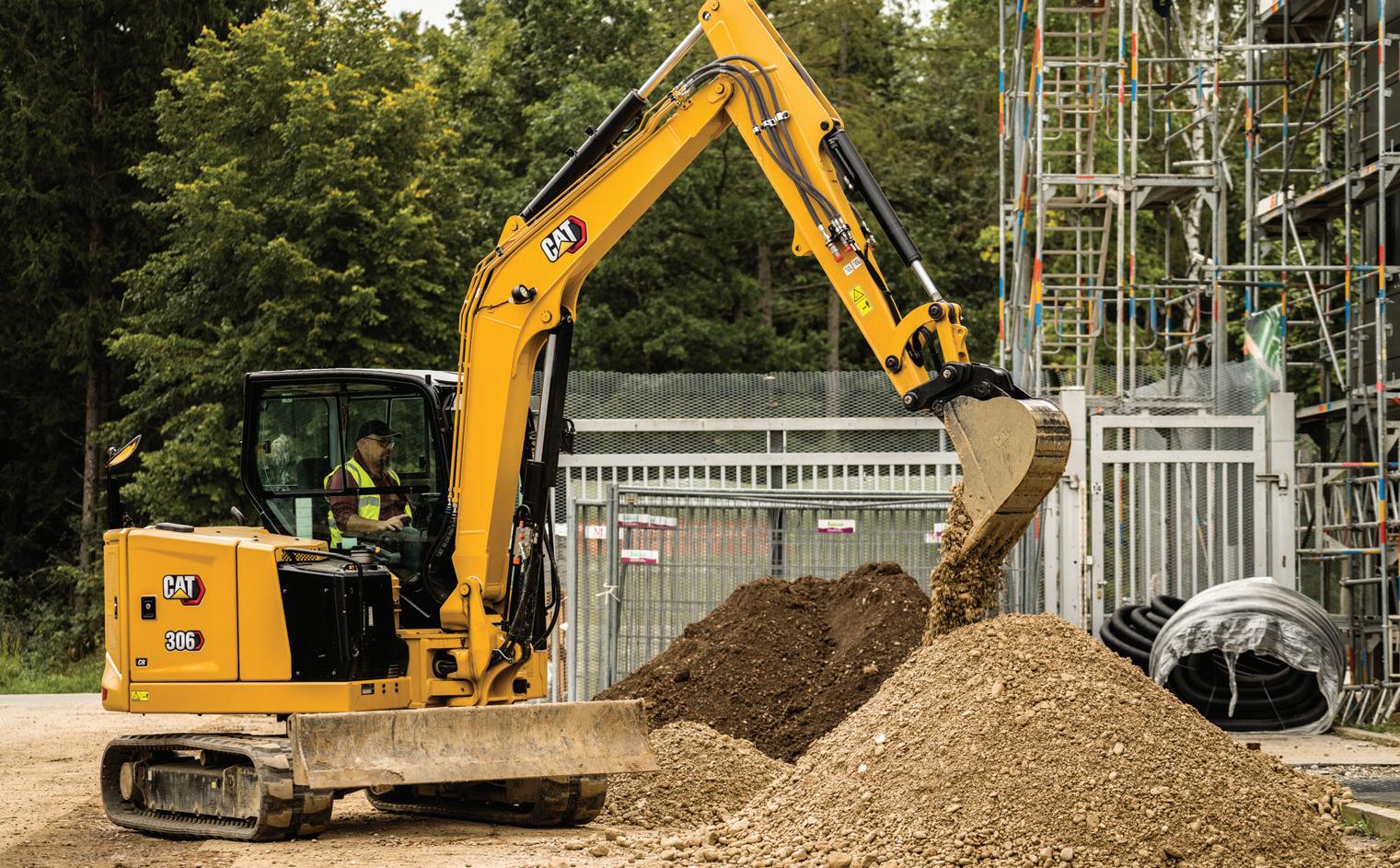










By Irwin Rapoport CEG CORRESPONDENT
As Georgia’s population and economy surge, the need for an enhanced road network has never been greater, and the state’s multi-billion-dollar Major Mobility Investment Program (MMIP) is building the infrastructure to meet immediate and future demands.
The Georgia Department of Transportation (GDOT) recently announced its largest MMIP private sector partner selections in state history. The August 2024 State Transportation Board approved proposals for both the $4.6 billion State Route 400 Express Lanes and the $1.2 billion Interstate 285/Interstate 20 West Interchange projects.
GDOT Commissioner Russell R. McMurry spoke at the August board meeting on the groundbreaking nature of the back-to-back billion-dollar MMIP milestone award announcements. The public-private partnership approach, noted the DOT, reduces the public funding needed since the private sector partner will finance the projects. Everyday commuters, freight and public transit all reap the future benefits.
“This is a public-private partnership and the last ‘P,’ which stands for partnership, is key to the success of these projects,” McMurray said. “That partnership is with both teams through the procurement process. By far, these two teams presented proposals to accomplish far more than we could do with our current funding. I can’t say enough of both teams’ interest in Georgia to work with Georgia DOT and SRTA to deliver mobility options in the SR 400 and I-285 west corridors.”

Rivian Automotive, an Irvine, Calif.based manufacturer, has received a loan for up to $6.6 billion from the U.S. Department of Energy’s (DOE’s) Advanced Technology Vehicle Manufacturing (ATVM) Loan Program to support the construction of Rivian’s next facility in Stanton Springs North, near Atlanta.
The funding also will help accelerate the company’s growth in the design, development and manufacturing of its electric vehicles, which include the R2 model, a midsize
SUV and the R3/R3X, a midsize crossover.
The new facility will be built in two phases, each featuring 200,000 units of annual production capacity, according to Rivian.
Phase One is expected to be completed in 2028, with the company creating 7,500 operations jobs through 2030.
“This loan will help create thousands of new American jobs and further strengthen U.S. leadership in EV manufacturing and technology,” RJ Scaringe, Rivian’s founder and CEO, noted in a statement. “[It] would
enable Rivian to more aggressively scale our U.S. manufacturing footprint for our competitively priced R2 and R3 vehicles that emphasize both capability and affordability.
A robust ecosystem of U.S. companies developing and manufacturing EVs is critical for the U.S. to maintain its long-term leadership in transportation.”
The Atlanta Journal-Constitution reported that DOE’s loan commitment will provide Rivian with the financial backing to build its plant in southern Morgan and Walton coun-
ties, roughly an hour east of Atlanta along Interstate 20.
With the loan, which requires Rivian to meet certain conditions, the company said it plans to begin EV production in 2028 but has not shared a timeline for resuming construction at the site.
In addition to the pending federal loan, Rivian is set to benefit from a roughly $1.5 billion incentive package offered by state and local leaders. The bulk of those incen-
see LOAN page 6















































































































Your choice of a sealed or pressurized cab is equipped with system, adjustable wrist rests and a suspension seat to help comfortably all day long. Controls are easy to use, and the i monitor provides customizable machine operator preferenc information.
Maneuvering on the jobsite is even easier with the Cat Stick traditional travel controls with levers and pedal to joystick c button.
an improved air conditioning p keep you working ntuitive Next Generation es and easy to read machine
Increased lifting, swinging and travel and multi-functional pe k Steer option. Switch from controls with a push of a erformance help you get the
are just a few of the safety feature
Maintenance is quick and easy on access at ground level with group
with a variable displacement pum es built into the
the Cat 306 CR. Routine check poi ped service points and robust servic &
mp, the Cat 306 CR was designed to ints are easy to ce panels. reduce operating
blade, angle blade or Extra Tool C
Contact our dealership today t excavator in the market. arrier (XTC). to learn more about the newest 6-t
The I-285/I-20 west interchange is ranked as the sixthworst truck bottleneck in the country by the American Transportation Research Institute. The project will reconstruct and widen several interstate system-to-system ramps at the I-285/I-20 Interchange west of Atlanta and add a combination of collector-distributor lanes and auxiliary lanes along I-20 west of the interchange and along I-285 north of the interchange.
The private sector partner team, Legacy Infrastructure Contractors, will complete the final design and construction. Legacy consists of C.W. Matthews Contracting Co. Inc. as the lead construction contractor and Infrastructure Consulting Engineering LLC as the lead engineering firm.
The project has been in development since 2018, beginning soon after the MMIP was announced.
GDOT anticipates the interchange construction to start in 2025, with substantial completion expected by 2030.
Meantime, SR 400 Peach Partners was selected for the final design, construction, financing, toll operations and maintenance of the SR 400 Express Lanes in accordance with contractual parameters managed by GDOT and the State Road and Tollway Authority. SR 400 Peach Partners is a three-party consortium between Acciona Concessions, ACS Infrastructure and Meridiam that will rely on a Dragados and Acciona Construction joint venture to carry out the design and construction.
The project will add express lanes in both directions along an approximately 16-mi. section of SR 400 from the North Springs MARTA Station (Exit 5C) in Fulton County to approximately 1 mi. north of McFarland Parkway (Exit 12) in Forsyth County.
As with the existing operational express lanes in Georgia,

the new lanes will have variable-priced tolls that give drivers the choice of bypassing congestion and enjoying improved mobility options.
GDOT said its role is to understand how transportation infrastructure can be built and operated to enable the people and freight movement that such growth requires. The State Strategic Transportation Plan first developed in 2009 indicated that adding express lanes to metro Atlanta’s highways — including along the SR 400 corridor — is the most effective way to ensure reliable access to major job centers, both for commutes by car and by bus.
“Adding managed lanes to SR 400, the economic engine of north Fulton County, will not only enhance mobility and reduce congestion but also pave the way for even greater economic development,” said Brandon Beach, the executive director of True North 400. “I believe this transformative infrastructure investment from Georgia DOT will allow the growing and top-ranked cities of North Fulton to attract
employers and create a more prosperous future for the entire region.”
GDOT anticipates the SR 400 express lanes’ construction to start by 2026. Substantial completion is expected in 2032.
Earlier this year, crews completed the SR 400 Phase 1 Bridge Replacements project, which was pulled forward to support the upcoming express lanes. That resulted in three new overpass bridges at Pitts Road, Roberts Drive and Kimball Bridge Road being constructed in Sandy Springs and Alpharetta. The bridges increase mobility and enhance safety in the area ahead of the express lanes’ construction.
As part of the SR 400 bridge replacements, multiuse paths were incorporated for increased pedestrian and bicycle access. The design-build delivery of the structures resulted from the department’s collaboration with the cities of Sandy Springs and Alpharetta. Both were partial project funders.
As part of the MMIP, more than 30 bridges are completed or under construction in key corridors such as along the I285/I-20 interchange on the east side, SR 400, I-85 north of metro Atlanta and in the Savannah metro area along I-16/I95.
Since being announced in 2016, GDOT has delivered completed MMIP projects.
Open-to-traffic projects include the I-85 Phase 1 and Phase 2 widening improvements as well as several Advanced Improvement Projects (AIP). The AIP is a subset of the larger MMIP initiative to make future construction less cumbersome and more efficient for future express lanes on I-285 and SR 400. Other MMIP projects, such as the I-285/I20 East Interchange and the I-16/I-95 Improvement Projects, will open within two years. CEG
(All photos courtesy of the Georgia Department of Transportation.)
tives are only realized once the automaker builds its factory and delivers on promises.
Rivian said its Georgia factory will encompass 9 million sq. ft. and have the capability of producing up to 400,000 vehicles by 2032.
Clayco, the nationwide construction company headquartered in Chicago (and maintains an Atlanta office) has been chosen to build Rivian’s future multi-billion electric vehicle factory in Georgia.
Rivian’s Georgia plant has been billed as the second-largest economic development project in state history behind Hyundai Motor Group’s $7.6 billion EV plant near Savannah.
The Atlanta news source noted that Rivian, which announced the project in late 2021, originally planned to open the factory this year, but the timeline slipped as the upstart automaker slogged through supply chain issues and other challenges.
The manufacturer indefinitely paused the factory’s construction in March as a temporary cost-cutting measure and shifted initial
production of its new crossover model, the R2, to its existing plant in Illinois.
Despite the temporary shutdown, Rivian has said it is committed to building its next production plant in Georgia, where it has said it will expand production of the R2 and produce at least two other future models, the R3 and R3X.
U.S. Sen. Jon Ossoff, D-Ga., applauded the loan agreement, saying in a statement that it will help bolster Georgia’s burgeoning EV manufacturing sector.
“Our federal manufacturing incentives are driving economic development across the state of Georgia,” he added.
Gov. Brian Kemp (R) convinced Rivian to choose Georgia for its second factory in 2021.
The newly-approved federal construction loan consists of $5.98 billion in principal that Rivian can use to finance factory construction while it also is responsible for $592 million of capitalized interest, meaning the company is liable for nearly $6.6 billion.
The Georgia Department of Economic Development (GDEcD) and the joint
Development Authority of Jasper, Morgan, Newton, and Walton counties confirmed that the state-owned land where the factory is planned cannot be used by Rivian as collateral.
Additionally, Rivian is required to provide a letter of credit as collateral for any recoupment payments if the company fails to meet its required job and investment targets.
The DOE noted in a news release that Rivian must develop and implement a “Community Benefits Plan” to engage with the surrounding community and local labor groups as it assembles its workforce.
Rivian’s loan would come from the Department of Energy’s ATVM loan program, established in 2007 to support domestic energy projects. EV factories by Ford, Nissan, and Tesla previously received financing through this initiative, according to the Atlanta newspaper.
As part of the loan evaluation process, the DOE conducted an environmental review of the roughly 1,800-acre Rivian site after residents living near the graded site became concerned over muddy runoff escaping onto their properties and fears about their water supplies.
But the assessment reached a preliminary conclusion that the factory would not have a significant environmental impact. The DOE incorporated an evaluation the U.S. Army Corps of Engineers completed almost two years ago for a key wetlands permit, but also reviewed potential health and quality of life impacts associated with the project, such as noise, traffic and air pollution.
In summary, the draft found “providing a federal loan to Rivian to build an EV manufacturing facility will not have a significant effect on the human environment.”
While the R2 crossover is expected to first be built at Rivian’s Illinois factory, the Georgia plant is vital to the automaker’s long-term future, company leaders told the Journal-Constitution.
In a July letter to Energy Secretary Jennifer Granholm, Ossoff wrote that the DOE loan is needed to get the Rivian project across the finish line.
“The state of Georgia has already invested in the success of Rivian and without this federal funding those taxpayer dollars could go to waste,” Ossoff wrote.









